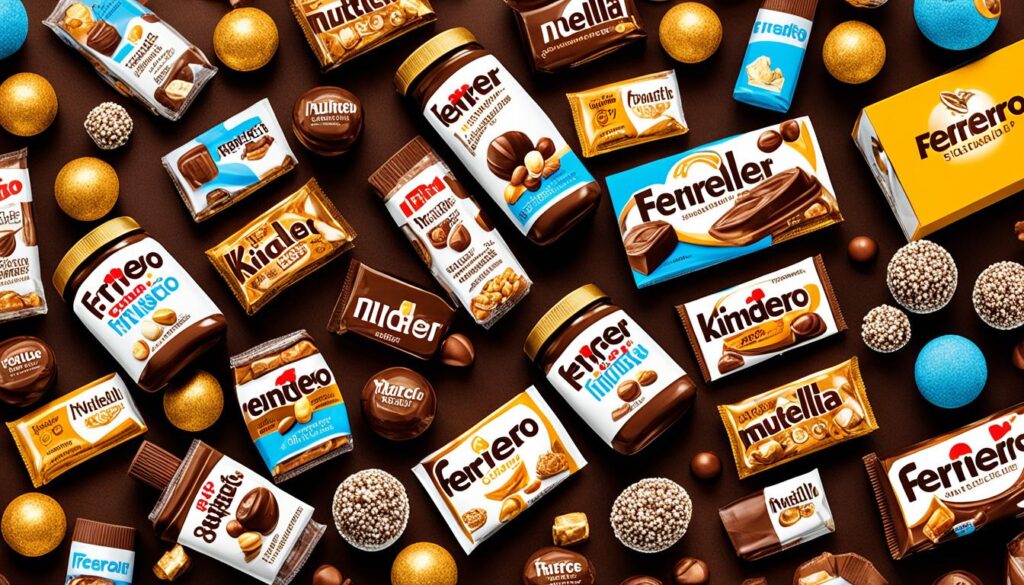Have you ever wondered about the fascinating history behind Nutella? How did this beloved chocolate-hazelnut spread come to be? Join us on a journey through time as we uncover the remarkable origins of Nutella and explore the rich history of gianduia, the secret ingredient that makes it so irresistible.
But first, let’s go back to the early 1800s, a time of war and innovation, when a small town in Italy played a crucial role in shaping the future of chocolate.
- Discover the historical context behind the creation of Nutella
- Learn about the origins of gianduia and its significance in Italian chocolate history
- Uncover the role of the Ferrero family in the rise of Nutella and Ferrero Rocher
- Explore the enduring legacy of Nutella and its global impact
- Appreciate the ingenuity and innovation of Italian chocolatiers throughout history
The Ferrero Rocher Factory in Alba
Alba, a city in the Piedmont region of Italy, is not only famous for its delicious truffles but also as the hometown of the Ferrero Rocher factory. The Ferrero family, who founded the chocolate factory, has deep ties to the town of Alba. The story of the Ferrero family begins with Pietro Ferrero, who moved to Alba in 1925 and opened a pastry shop with his wife Piera. They started small but soon expanded their operation to include a shop in Turin as well.
After World War II, Pietro and Piera’s son Michele joined the business and played a key role in its growth and success. Under Michele’s leadership, the Ferrero chocolate factory became a leader in the industry, known for its innovative technologies and popular products like Nutella and Ferrero Rocher.
Today, the Ferrero headquarters is still located in Alba, and the factory continues to be a source of pride for the town. The Ferrero Rocher factory in Alba is not only a place of production but also an embodiment of the Ferrero family’s commitment to quality and innovation. With a rich history and a dedication to crafting delightful chocolate treats, the Ferrero Rocher factory in Alba stands as a testament to the enduring legacy of the Ferrero family and their contribution to the chocolate industry.
The Impact of the Continental System on Gianduia
The Continental System, implemented by Napoleon in 1806 as part of his trade policy, had a profound effect on the production and popularity of gianduia during that time. The objective of this trade policy was to weaken England’s economy by blocking its access to European markets. As a consequence of the Continental System, the supply of cacao, the main ingredient in chocolate, was severely limited.
This scarcity of cacao prompted chocolatiers in Turin to devise a creative solution: blending hazelnuts with the limited amount of chocolate available. Thus, gianduia, a delightful mixture of hazelnuts and chocolate, emerged as a popular alternative to pure chocolate. The harmonious combination of flavors and the affordability of gianduia made it a beloved treat during the Continental System era.
However, as the Continental System faced challenges such as corruption and British retaliation, the availability of cacao gradually improved. Consequently, pure chocolate regained its popularity as the scarcity dwindled. Nonetheless, gianduia had already made its mark and continued to thrive as a beloved chocolate-hazelnut blend.
Effect of the Continental System on the Chocolate Industry
The Continental System had far-reaching effects on the chocolate industry as a whole. The scarcity of cacao during that period forced chocolatiers to explore alternative ingredients and techniques to sustain their trade. This led to the development of creative blends like gianduia, which showcased the ingenuity of chocolatiers in adapting to challenging circumstances.
Additionally, the popularity of gianduia during the Continental System era laid the foundation for future chocolate-hazelnut creations, shaping the direction of the chocolate industry. The combination of hazelnuts and chocolate became more than just a temporary solution – it became a flavor profile that captivated palates and stood the test of time.
The Rise of Gianduia and Nutella in Alba
In Alba, the birthplace of gianduia, this chocolate-hazelnut creation became a local specialty and a popular treat among the residents. The Ferrero family, who had a strong presence in Alba, played a significant role in popularizing gianduia and later, Nutella. After Pietro Ferrero’s successful creation of Pasta Gianduja, he realized there was potential to make the treacly substance even creamier and easier to spread on bread. He altered the recipe, resulting in a spreadable version known as Supercrema Gianduja, which later became Nutella.
Nutella quickly gained popularity in Alba and soon became a staple in Italian households. The name change from Supercrema Gianduja to Nutella in 1964 made the product more approachable to consumers. From the local invention of gianduia to the worldwide success of Nutella, Alba and the Ferrero family played a vital role in the rise of these beloved chocolate-hazelnut creations.
Gianduia’s popularity in Alba can be attributed to its rich history in the region and its status as a local specialty. The unique combination of chocolate and hazelnuts in gianduia captivated the taste buds of locals and became a beloved treat. The Ferrero family’s innovation and dedication to enhancing gianduia led to the creation of Nutella, which further solidified the chocolate-hazelnut blend as an Italian staple.
The birthplace of gianduia and the rise of Nutella in Alba showcases the ingenuity of the Ferrero family and their commitment to creating exceptional chocolate products. The popularity and success of Nutella not only in Alba but also around the world are a testament to the timeless appeal of this delectable combination.
Gianduia: A Local Specialty in Alba
Gianduia’s roots can be traced back to Alba, where the chocolate-hazelnut confection gained fame and popularity among the locals. The unique flavor and creamy texture of gianduia quickly established it as a specialty in Alba, highlighting the region’s rich history and expertise in producing exceptional chocolate creations.
Nutella: An Italian Staple
After its invention, Nutella swiftly became an essential part of the Italian culinary landscape. The delectable spread made from gianduia captivated the hearts of Italians and soon found its way into pantries across the country. Nutella’s versatility, whether enjoyed on toast, crepes, or used as an ingredient in various desserts, solidified its status as an Italian staple.
| Gianduia | Nutella |
|---|---|
| A local specialty in Alba | An Italian staple |
| Rooted in the region’s history | Embodies Italian culinary tradition |
| Chocolate-hazelnut confection | Spreadable gianduia cocoa cream |
| Popular among locals | Loved by people worldwide |
The Enduring Legacy of Ferrero and Nutella
The success story of Ferrero and Nutella extends far beyond the town of Alba. Building upon their initial achievements, Nutella and Ferrero Rocher have propelled the Ferrero Group to expand globally, boasting a network of 25 factories worldwide. Despite the scale of their operations, the company remains deeply committed to its local communities, exemplifying the Ferrero family’s enduring legacy.
One of the ways Ferrero demonstrates its commitment to local communities is through initiatives like “Villa Piera” at its German plant. This modern accommodation provides a comfortable living environment for employees, illustrating the company’s dedication to improving the quality of life for its workforce.
Furthermore, Ferrero’s constant focus on innovation has resulted in the creation of numerous iconic products that continue to captivate consumers. Kinder, Tic Tac, and Ferrero Rocher are just a few examples of the innovative and beloved treats brought to market by Ferrero.

Ferrero’s Legacy: A Testament to Italian Ingenuity
Ferrero’s legacy goes far beyond the creation of Nutella. It stands as a testament to the ingenuity and creativity that Italian chocolatiers possess. From the humble beginnings of Pasta Gianduja to the worldwide recognition of Nutella, Ferrero’s enduring legacy is a celebration of Italian craftsmanship and the unwavering love for chocolate-hazelnut delicacies.
Conclusion
The enthralling history of Nutella and gianduia reveals the ingenuity and resourcefulness of Italian chocolatiers, the vision of the Ferrero family, and the enduring legacy of these beloved chocolate-hazelnut creations. The origins of gianduia during the Napoleonic Wars, when chocolatiers in Turin mixed cocoa and hazelnuts to stretch their chocolate supply, set the stage for the creation of Nutella decades later. From its humble beginnings as Supercrema Gianduja to its iconic status as Nutella, this delectable spread has captured the taste buds and hearts of millions around the world.
The Ferrero Rocher factory in Alba, the hometown of the Ferrero family, stands as a testament to their commitment to innovation and quality. The factory not only produces Nutella but also other iconic chocolate products like Ferrero Rocher, Kinder, and Tic Tac. The success of the Ferrero Group, with its 25 factories worldwide, is a testament to the enduring legacy of the Ferrero family and the love for their chocolate creations.
Whether enjoyed on a slice of bread, drizzled over pancakes, or used as an ingredient in countless recipes, Nutella has become a staple in households around the world. Its rich history, from gianduia’s origins to the Ferrero family’s dedication to perfection, has created a timeless and beloved treat. Nutella’s legacy is a reminder of the joy and delight that can be found in a simple combination of chocolate and hazelnuts.
